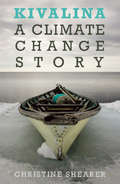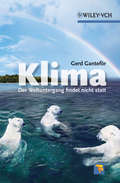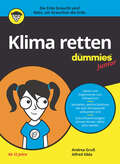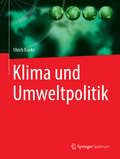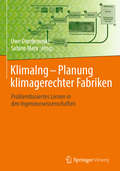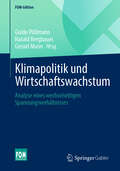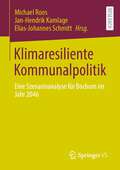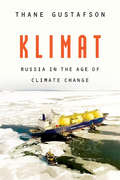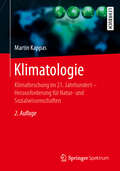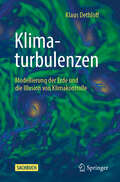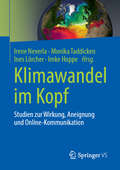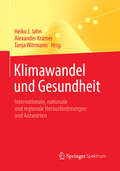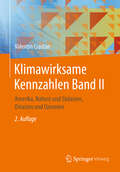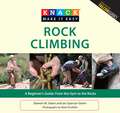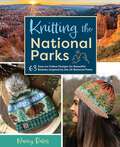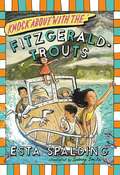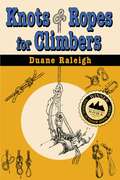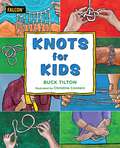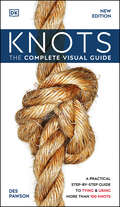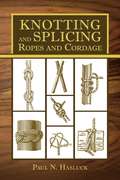- Table View
- List View
Kitty Literature: An Illustrated Collection for Cat Lovers
by William Shakespeare L. Frank Baum Rudyard Kipling Miguel De Cervantes Edgar Allan Poe Charles Darwin Emily Dickinson Mark Twain Charles Dickens Louisa May Alcott Alexandre Dumas Lewis Carroll Henry David Thoreau Oscar Wilde John Greenleaf Whittier Sir Walter Scott Washington Irving Anton Chekhov Lafcadio Hearn Beatrix Potter John Keats Bram Stoker Harriet Beecher Stowe H. P. Lovecraft Carl Sandburg E. E. Cummings John Muir Leonardo Da Vinci William Wordsworth W. B. Yeats Charles Baudelaire William Carlos Williams The Brothers Grimm Percy Bysshe Shelley John Richard Stephens Arthur Rackham Vincent Van Gogh John James Audubon Paul Gauguin Francisco José de Goya y Lucientes Teddy Roosevelt Louis Wain Samuel F. B. Morse Goya Ando Hiroshige Pierre-Auguste Renoir Thomas Eakins Henri RousseauPeople have been fascinated by cats for centuries. From the ancient Egyptians, all the way down to today's cat lovers throughout the world, cats have held a special place in people's lives. Cats are unique creatures. It shouldn't be surprising that they have captured the imaginations of many of the world's greatest authors and artists.This book contains 229 illustrations selected from the world's best cat art by 49 great artists, and explores stories, poetry, essays and quotations on cats by 36 of the most acclaimed and classic writers.From Beatrix Potter to Louisa May Alcott to Teddy Roosevelt, this eclectic collection features writings about cats by such great masters as Dickens, Kipling, Chekhov, Poe, Lovecraft, Keats, Shelley, Yeats, Whittier, Audubon, Muir, Thoreau, and Mark Twain, accompanied by fine art museum pieces by Renoir, da Vinci, van Gogh, Rousseau, Hiroshige, Goya, Gauguin, and many others.Kitty Literature is perfect for anyone who lives with one or more cats. It will also make an excellent gift book.(306 pages, 229 illustrations)
Kivalina: A Climate Change Story
by Christine ShearerThe true story of an Alaska Native village destroyed by flooding and erosion caused by climate change—and how they fought for help.Warming Arctic temperatures have been making coastal areas of Alaska increasingly uninhabitable. In 2008, the small Alaska Native village of Kivalina filed a legal claim against some of the world’s largest fossil fuel companies for damaging their homeland and creating a false debate around climate change. Academic and former journalist Christine Shearer explores the history leading up to the lawsuit, its connections to disaster management and adaptation, and its relationship to past misinformation campaigns involving lead, asbestos, and tobacco. Kivalina’s struggle for safe relocation, the book argues, is part of our common struggle to acknowledge and address climate change before it is too late.2012 Rachel Carson Environment Book Award (Honorable Mention)Praise for Kivalina“Moving, infuriating, ominous . . . . Shearer provides an impressively concise and comprehensive history of the growth of corporate power in America; its influence on, entwinement with, and corruption of government; [and] corporate obfuscation of industrial hazards.” —Publisher’s Weekly“Best book of 2011: one of the most timely and important books to be published in 2011—and in the past decade.” —Jeff Biggers, The Huffington Post“In novelistic detail, Shearer recounts the science, politics, legal battles, and human experience at one of the leading edges of climate change impact. In doing so, she . . . tells the story not just of one village in Alaska, but of us all.” —The Society of Environmental Journalists
Klima
by Gerd GanteförPanikmache oder sicheres Weltende? Was vom "Klimawandel" wirklich zu halten istKaum ein Thema erregt die Gemüter so wie die Frage, ob der Klimawandel uns alle ins Verderben stürzt oder wir nur einer Angst fördernden Kampagne hysterischer Umweltaktivisten aufsitzen. Die Diskussionen werden heiß geführt und münden oft in extreme Positionen und widersprüchliche Szenarien. Und eines ist bei alldem selten zu finden: verlässliche Orientierung. Genau diese bietet Gerd Ganteför mit seinem Buch.Orientierung durch WissenGerd Ganteför überprüft die gängigen Argumente, Mythen und Legenden: unabhängig, seriös und wissenschaftlich fundiert. So leistet er nicht nur eminent wichtige Aufklärungsarbeit, sondern fördert auch einige handfeste Überraschungen zu Tage. Der staunende Leser erfährt etwa, dass Flugreisende energieeffizienter unterwegs sind als Autofahrer, und er bekommt eine Vorstellung davon, was die Menschheit bei der nächsten Eiszeit erwartet. Ganz nebenbei vermittelt der Autor dabei fundiertes Wissen zu den zentralen Zukunftsthemen Klima und Energie.Provokation mit ArgumentenGanz bewusst tritt Gerd Ganteför der grassierenden "Lust am Untergang" entgegen. So verweist er auf die Vorteile der Klimaerwärmung, bindet Kohle- und Kernkraftwerke in eine Strategie zum Naturschutz ein und bescheinigt den Verfechtern regenerativer Energien, einem schönen Traum nachzuhängen. Selten sind solche Thesen mit so guten Argumenten vertreten worden wie in diesem Buch.
Klima retten für Dummies Junior (Für Dummies)
by Andrea Gruß Alfred SiblaDu willst was für das Klima tun? Nicht mehr abwarten? Damit du richtig durchstarten kannst, erklärt dir dieses Buch in kurzen Texten, was beim Klimawandel und der Erderwärmung passiert. Die reinen Fakten werden kombiniert mit einfachen Experimenten. Du hast dann gegenüber deinen Freunden und Eltern viel bessere Argumente. Du erfährst, wo die Gefahren des Klimawandels liegen, welche Zukunftstechnologien es gibt, die zur Lösung der Klimakrise beitragen können, und was du selbst tun kannst. Erfahre, wie auch du im Alltag zum Klimaretter wirst. Bestens geeignet für Kinder und Jugendliche ab 12 Jahren.
Klima und Umweltpolitik
by Ulrich RankeDer Klimawandel findet jetzt und überall statt ist. Das Buch legt die institutionellen Rahmenbedingungen dar, die notwendig sind, um im Kampf gegen den Klimawandel die Emissionen unter dem notwendigen Schwellwert von 2 °C zu halten. Ohne internationale Zusammenarbeit und grenzüberschreitende Initiativen wird dieses Ziel nicht zu erreichen sein. Eine Auswahl der bedeutendsten Klimaabkommen wird in diesem Buch in den naturwissenschaftlichen Kontext der Klimagenese gestellt und auf ihre sozioökonomischen und kulturellen Auswirkungen hin beleuchtet. Dazu werden zunächst die Themenfelder Klimawirkungen und die wissenschaftlichen Grundlagen des Klimageschehens beschrieben. Es werden die institutionellen und technischen Instrumente der Klimaschutzpolitik diskutiert und ausführlich ausgewählte Konferenzen unter dem Dach der Vereinten Nationen dokumentiert. Nach Paris 2015 lässt sich feststellen, dass der Klimawandel nur durch eine noch umfassendere Internationalisierung beeinflusst werden kann.
KlimaIng - Planung klimagerechter Fabriken: Problembasiertes Lernen In Den Ingenieurwissenschaften
by Uwe Dombrowski Sabine MarxDie mit dem Klimawandel verbundenen Risiken haben auch Konsequenzen für produzierende Unternehmen und ihre Produktionsstätten. Daher widmet sich das Buch der klimagerechten Planung von Fabriken und verknüpft dieses ingenieurwissenschaftliche Fachgebiet mit Grundlagenwissen zur Planung und Durchführung problembasierter Lehrveranstaltungen an Hochschulen. Im ersten Teil beschreiben die Autoren die Grundlagen des Klimawandels und der Fabrikplanung. Sie stellen zum einen die Vorgehensweisen zur Identifizierung von Klimarisiken und zum anderen Planungsansätze zu deren Reduzierung vor. Der zweite Teil verknüpft diese ingenieurwissenschaftlichen Aufgabenstellungen mit dem Konzept problembasierten Lernens. Dabei wird problembasiertes Lernen als Lehrmethode zum Erwerb und zur Anwendung praxisrelevanten Fachwissens verstanden, die stets die Lernenden in den Mittelpunkt stellt. Neben theoretischen Grundlagen und aktuellen Forschungsergebnissen zur Wirksamkeit problembasierten Lernens erhalten Leser hier auch Hinweise für die Implementation in der Praxis. Am Beispiel einer problembasierten Lehrveranstaltung, die im Rahmen eines Forschungsprojektes entwickelt wurde, wird eine didaktische Konzeption zur Planung und Durchführung problembasierter Lernumgebungen vorgestellt. Diese Modell-Lehrveranstaltung ist so aufbereitet, dass das Konzept ohne viel Aufwand auf andere Themengebiete der Ingenieurwissenschaften übertragen werden kann. Der dritte Teil des Buchs bietet eine Fallsammlung zu unterschiedlichen Lernzielen. Diese dienen Nutzern als Vorlage, um selbst geeignete Fälle für problembasierte Lernumgebungen zu konstruieren. Das Buch richtet sich an Lehrkräfte in ingenieurwissenschaftlichen Studiengängen, insbesondere solche mit dem Schwerpunkt Klimawandel und Fabrikplanung.
Klimapolitik und Wirtschaftswachstum: Analyse eines wechselseitigen Spannungsverhältnisses (FOM-Edition)
by Harald Bergbauer Gerald Mann Guido PöllmannDieser Sammelband greift aktuelle Fragestellungen zum Spannungsverhältnis zwischen der Klimapolitik und der Generierung von Wirtschaftswachstum auf. Spätestens mit der Institutionalisierung des Klimaschutzes im nationalen wie im europäischen Rahmen wurde das Spannungsfeld zwischen Klimapolitik und Wirtschaftswachstum in aller Schärfe deutlich. Wissenschaft und Politik stellten die grundsätzliche Frage, wie unter den institutionalisierten Bedingungen des Klimaschutzes marktwirtschaftlich konform Wirtschaftswachstum generiert werden kann. Kann von staatlicher Klimapolitik eine ökonomische Anreizwirkung ausgehen, oder stellt sie vornehmlich ein volkswirtschaftliches Hindernis dar? Welche Einnahmen und welche Ausgaben sind mit staatlicher Klimapolitik verbunden? Wie hoch sind die Kosten, wie hoch ist der Ertrag? Diesem Spannungsfeld möchte sich der vorliegende Sammelband stellen.
Klimaresiliente Kommunalpolitik: Eine Szenarioanalyse für Bochum im Jahr 2046
by Michael Roos Jan-Hendrik Kamlage Elias-Johannes SchmittDie konkreten gesellschaftlichen Folgen des Klimawandels sind sehr unsicher und nicht vorhersagbar. Die Szenarioanalyse erlaubt es, Vorstellungen möglicher Zukünfte zu entwickeln. Das Buch stellt vier kohärente Zukunftszenarien für die Stadt Bochum im Jahr 2046 vor und zeigt, wie daraus konkrete Maßnahmen für politische Entscheidungsträger*innen hergeleitet werden können. Die Leser*innen dringen in utopische und dystopische Erzählungen ein, die die wissenschaftlich fundierte Entwicklung der Szenarien anschaulich werden lassen. Darüber hinaus bietet das Buch eine Einführung in die Methode der Szenarioanalyse, die für den Aufbau von Aktivitäten der städtischen Vorausschau (Urban Foresight) auch in anderen Kommunen hochgradig relevant ist.
Klimat: Russia in the Age of Climate Change
by Thane GustafsonA discerning analysis of the future effects of climate change on Russia, the major power most dependent on the fossil fuel economy. Russia will be one of the countries most affected by climate change. No major power is more economically dependent on the export of hydrocarbons; at the same time, two-thirds of Russia’s territory lies in the arctic north, where melting permafrost is already imposing growing damage. Climate change also brings drought and floods to Russia’s south, threatening the country’s agricultural exports. Thane Gustafson predicts that, over the next thirty years, climate change will leave a dramatic imprint on Russia. The decline of fossil fuel use is already underway, and restrictions on hydrocarbons will only tighten, cutting fuel prices and slashing Russia’s export revenues. Yet Russia has no substitutes for oil and gas revenues. The country is unprepared for the worldwide transition to renewable energy, as Russian leaders continue to invest the national wealth in oil and gas while dismissing the promise of post-carbon technologies. Nor has the state made efforts to offset the direct damage that climate change will do inside the country. Optimists point to new opportunities—higher temperatures could increase agricultural yields, the melting of arctic ice may open year-round shipping lanes in the far north, and Russia could become a global nuclear-energy supplier. But the eventual post-Putin generation of Russian leaders will nonetheless face enormous handicaps, as their country finds itself weaker than at any time in the preceding century. Lucid and thought-provoking, Klimat shows how climate change is poised to alter the global order, potentially toppling even great powers from their perches.
Klimatologie: Klimaforschung im 21. Jahrhundert - Herausforderung für Natur- und Sozialwissenschaften
by Martin KappasKlimaforschung – Einführung in eine „Mega-Science"Die zweite Auflage des Lehrbuchs zur Einführung in die Klimatologie greift die Entwicklung als globale "Erd-Systemwissenschaft" auf. Sie ist hoch interdisziplinär, extrem problemgetrieben und zunehmend in internationale Zusammenhänge eingebettet. Naturwissenschaftliche Untersuchungen verbinden sich hier mit gesellschaftswissenschaftlichen Fragestellungen und Grundlagenforschung mit politischen Rahmensetzungen.Das Werk besteht aus drei miteinander vernetzten Teilen:I: Klimatologie als WissenschaftII: Klimawandel und Global ChangeIII: Wechselwirkungen: Klima – Mensch, Gesellschaft und PolitikDieses Buch liefert neue Einsichten zu Zusammenhängen im Bereich Erdsystemforschung und stellt das Konzept des „Anthropozäns“ vor, welches die Anerkennung einer radikal veränderten Mensch-Umwelt-Beziehung in den Vordergrund gerückt hat. Der Fokus der Neuauflage liegt auf den Verbindungen zwischen verschiedenen sozialen und ökologischen Prozessen und greift dabei auf die aktuellen Reports des IPCC zurück. Es ermöglicht Lesern Wissen über die ökologischen und menschlichen Aspekte des globalen Wandels aufzubauen und Lösungen für eine nachhaltige Entwicklung zu finden.Anders als bisherige Lehrbücher der Klimatologie geht das Werk sehr ausführlich auf das hoch aktuelle Themenfeld "Global Change" ein und verdeutlicht die gesellschaftliche Relevanz der Klimaforschung. Zahlreiche Abbildungen zeigen komplexe Klimaphänomene, aber auch internationale Forschungsnetzwerke und politische Strukturen auf.Dieses Buch sticht durch seinen interdisziplinären Ansatz hervor und wird insbesondere Forscher ansprechen, die sich für Themen im Bereich Globaler Umweltwandel interessieren. Es eröffnet neue Perspektiven auf die Zusammenhänge von Klima, Ozean, Waldbedeckung und Landnutzung sowie die Veränderung dieser Bereiche im Erdsystem. Leser gewinnen einen Überblick über die komplexen Forschungsstrukturen (Future Earth) und das Weltklimaprogramm.
Klimaturbulenzen: Modellierung der Erde und die Illusion von Klimakontrolle
by Klaus DethloffDer Klimawandel wird durch anthropogene Emissionen von Treibhausgasen aber auch komplexe natürliche Prozesse beeinflusst, die sich menschlicher Kontrolle weitestgehend entziehen. Die Berichte des IPCC erzeugen einen wissenschaftlich und politisch ausgehandelten Konsens, in dessen Folge die regierenden Eliten suggerieren, durch eine CO2 Steuer das Klima kontrollieren zu können. Diese und andere Maßnahmen basieren jedoch oft auf unsicheren Annahmen der Klimaforschung. Klimaprojektionen der Zukunft beruhen auf Modellen, deren Fehler zu groß sind und die interne Klimavariabilität unterschätzen. In mittleren Breiten können interne Klimatrends anthropogene Einflüsse sogar übertreffen. Wichtige Prozesse wie die geothermische Erwärmung der Ozeane werden zudem in allen Modellen vernachlässigt. Daher muss sich die menschliche Zivilisation auf unvorhersehbare Überraschungen vorbereiten, da interne Variabilität zu erheblicher Unsicherheit in den Klimaprojektionen führt und die Kontrolle des Klimawandels verhindert. Klimaänderungen haben komplexe ökonomische, ökologische, geopolitische sowie soziale Auswirkungen. [SS3] Die durch Medien und Politik dominierte Meinungsmaschinerie ignoriert die Unsicherheiten der Klimaprojektionen und benutzt diese für regionale Anpassungsmaßnahmen. In den wohlhabenden G7 Ländern und der EU wird eine unrealistisch schnelle Umstellung von fossilen Energieträgern auf erneuerbare Energien angestrebt. Die Diskussion um eine Dekarbonisierung der Industrie innerhalb von Jahrzehnten ist kontrovers, da eine Versorgungssicherheit mit regenerativen Energien in diesen Zeiträumen nicht erreichbar ist. Angesichts geopolitischer Spannungen steigt das Risiko eines Atomkriegs wieder an, was die Diskussionen um verstärkten Klimaschutz und militärische Aufrüstung widersprüchlich erscheinen lässt. Das Damoklesschwert einer gefahrenreichen Klimazukunft zwingt uns, politische und soziale Kurskorrekturen vorzunehmen und glaubwürdige Strategien zur nachhaltigen Nutzung unserer begrenzten Ressourcen zu entwickeln. Dieses Buch lädt Sie ein, die komplexen Zusammenhänge und die oft verschwiegenen Unsicherheiten der Klimaforschung zu erkunden. Über die Klimawissenschaften führt es zu einer tieferen Erkenntnis über unsere wirkliche Rolle in den globalen Klimaturbulenzen.
Klimawandel im Kopf: Studien zur Wirkung, Aneignung und Online-Kommunikation
by Monika Taddicken Irene Neverla Ines Lörcher Imke HoppeKlimawandel ist ein Meta-Thema - seit Jahrzehnten auf der Agenda der Medien, global diskutiert, mit vielen Anschlusspunkten in politische, wirtschaftliche, kulturelle Fragen und Alltagsbelange. Was aber findet sich in den Köpfen der Menschen zum Thema Klimawandel? Welche Kommunikationskanäle, welche journalistischen und welche Online-Angebote waren dafür wichtig, und wie hängen Wissen, Einstellungen und Verhaltensbereitschaften damit zusammen? Die mit verschiedenen Methoden erarbeiteten Ergebnisse in diesem Buch zeigen, wie ,eigensinnig' bzw. kreativ sich Menschen das Thema Klimawandel aneignen, wie vielfach vernetzt und ,rhizomartig' die klimabezogene Kommunikation verläuft.
Klimawandel und Gesundheit
by Alexander Krämer Heiko J. Jahn Tanja WörmannDer Klimawandel und die daraus resultierenden Auswirkungen auf Gesundheit, Umwelt und Gesellschaft werden in den nächsten Jahren sowohl lokal wie auch global wichtige Fragen sein, auf die Antworten gefunden werden müssen. Das Buch führt anhand der wesentlichen Aspekte der direkten und indirekten klimawandelbedingten Gesundheitsfolgen in das Thema ,,Klimawandel und Gesundheit" ein. Dabei wird herausgearbeitet, dass klimabedingten Gesundheitsfolgen nur wissenschaftlich-interdisziplinär sowie über administrative und hierarchische Ebenen und über geografische und politische Grenzen hinaus effektiv entgegengewirkt werden kann. Im Hinblick auf die Herausforderungen, die hierzulande zu bewältigen sind und sein werden, helfen die zusammengetragenen Fakten, die Öffentlichkeit und Politik für dieses Thema weiter zu sensibilisieren. Zudem finden Fachleuten und Experten in öffentlichen Verwaltungen (z B. in der Stadtplanung oder im öffentlichen Gesundheitsdienst) viele Fallbeispiele, die als Anregung für deren Arbeit für eine gesunde Umwelt dienen. Studierende wie Wissenschaftler der Gesundheitswissenschaften und angrenzender Disziplinen wie Geografie, Klimatologie, Stadtplanung und Architektur, Ökonomie und Sozialwissenschaften werden eine reiche Quelle an Informationen finden, um sie für die Forschung in diesem Bereich zu begeistern.
Klimawirksame Kennzahlen Band II: Amerika, Nahost und Südasien, Ostasien und Ozeanien
by Valentin CrastanDer Autor analysiert die Energiewirtschaft der geographischen Einheiten Amerika – unterteilt in Nordamerika (Kanada + USA) sowie Mittel- +Südamerika (spanisch-portugisischer Kulturkreis) – Nahost und Südasien sowie Ost-Asien und Ozeanien. Die wichtigsten energiewirtschaftlichen Indikatoren der einzelnen Regionen und Länder und deren Entwicklung werden von ihm in zahlreichen Grafiken und Energieflussdiagrammen veranschaulicht. Darauf basierend empfiehlt er eine Verteilung der zur Begrenzung des Klimawandels notwendigen Emissionsreduktion (für Klimaziel 2 °C oder weniger, mit Perspektive bis 2050).Die in diesem Band behandelten Erdteile verursachen zusammen 77 % der Emissionen. Europa + Eurasien sowie Afrika werden im ersten Band behandelt.
Knack Rock Climbing: A Beginner's Guide: From the Gym to the Rocks (Knack: Make It Easy)
by Stewart M. Green Ian Spencer-GreenKnack Rock Climbing gets people started by giving them fundamental knowledge about climbing, equipment, movement, and safety.
Knack Universal Design: A Step-by-Step Guide to Modifying Your Home for Comfortable, Accessible Living (Knack: Make It Easy)
by Barbara Krueger Nika StewartFrom the basics to insider practical tips on the latest trends and products, readers will learn what it takes to create a home that makes life easier.
Knickerbocker Snowstorm, The (Images of America)
by Kevin AmbroseOn the evening of January 28, 1922, several hundred people fought their way through the greatest snowstorm in Washington's history to see a show at the Knickerbocker Theater, the city's largest and most modern moving picture theater of the time. Unbeknownst to the theater patrons, the Knickerbocker Theater's flat roof was tremendously burdened by the weight of the snow. During the show's intermission, the snow-covered roof crashed down upon the crowd. As the roof fell, it collapsed the theater's balcony and pulled down portions of the surrounding brick walls, killing 98 people and injuring 133. Some of Washington's prominent politicians and business owners were among the casualties. The disaster ranks as one of Washington's worst in history, and the snowstorm continues to hold the record for Washington's single greatest snowfall.
Knife Edge
by Douglas ReemanAfter the murder of his father, Lieutenant-Colonel Mike Blackwood, Ross Blackwood finds himself assigned to the Far East, taking on rebels and illegal-arms dealers in Hong Kong and Malaysia. Along the way he meets another Blackwood, his cousin Steve, who has made a life for himself in the Corp, as an explosives expert. The two Blackwoods uphold the honor of their family and their chosen profession while negotiating the fallout of Britain's post-colonial politics.
Knitting the National Parks: 63 Easy-to-Follow Designs for Beautiful Beanies Inspired by the US National Parks
by Nancy BatesFrom the brightly colored pebbles of Lake McDonald in Montana&’s Glacier National Park to the regal granite cliffs of El Capitan and Half Dome in California&’s Yosemite Valley, the US National Parks contain some of the most recognizable and iconic natural landmarks in the world. Capture the majesty each national park offers with original beanie patterns created by knitting designer and outdoor enthusiast Nancy Bates. Beanies range from simple beanie constructions to more challenging stitch patterns such as the two-color crossovers inspired by South Dakota&’s Badlands or the multiple cable designs inspired by New Mexico&’s Carlsbad Caverns. Clear charts, easy-to-read keys, and thorough instructions help any knitter, whether beginner or experienced, through these gratifying projects. Show your love and appreciation of our national parks with these beautiful and practical beanie projects you can wear any time or any place. 63 KNITTING PATTERNS: Every US National Park is celebrated with a unique beanie design, including the newly designated park New River Gorge in West Virginia BEAUTIFULLY PHOTOGRAPHED: Each pattern is accompanied by photos of the finished beanie and gorgeous images of the park&’s landscapes that inspired it INSPIRED BY NATURE: Learn about each national park&’s unique fauna, flora, and landscapes that inspired each original beanie, from the Painted Wall in Colorado&’s Black Canyon of the Gunnison to the Salt Flats in California Death Valley EASY-TO-FOLLOW INSTRUCTIONS: Each of the 63 beanies knitting patterns have been tested and verified and offer clear charts so that knitters of every skill level can knit a beanie in no time.
Knock About with the Fitzgerald-Trouts
by Sydney Smith Esta SpaldingThe much-anticipated second book in a Dahl-esque middle-grade series by award-winning poet and screenwriter Esta Spalding, with illustrations by acclaimed artist Sydney Smith.Welcome to the further adventures of the plucky Fitzgerald-Trout siblings, who live on a tropical island where the grown-ups are useless, but the kids can drive.In this second installment, the delightfully self-reliant siblings continue their search for a home. This time, their pursuit will bring them face-to-face with a flood, illegal carnivorous plants, and the chance to win an extraordinary prize at a carnival. Will they finally find the place they truly belong?
Knots & Ropes for Climbers
by Duane Raleigh1998 National Outdoor Book Award winner. How to tie 35 climbing knots: step-by-step illustrations, easy-to-follow directions, when to use and not to use, and expert advice on selection and care of ropes.
Knots for Climbers (How To Climb Series)
by Craig LuebbenTeaches the reader the Twelve Essential Climbing Knots, and then presents eighteen others for various special situations. Color illustrations make learning these knots a cinch.
Knots for Kids (For Kids)
by Buck TiltonKnots for Kids delivers relevant, expertly curated content perfect for kids. Outdoor skills expert and veteran author Buck Tilton provides readers with accessible information on choosing the best knot for the situation, tying different types of common knots and hitches, selecting the best kinds of rope, and much more. With step-by-step instructions (for both righties and lefties!) on tying the most used and useful knots, this is the perfect book to teach children how to tie knots like the experts.
Knots: The Complete Visual Guide
by DKThe ultimate visual guide to all types of knots. Avoid getting yourself into a tangle by following detailed step-by-step instructions that show you how to tie and untie more than 100 knots. Whichever knotty scenario you find yourself in, from in your own garden, to up in the mountains or across seas, this reference book will take you from novice to expert rope tier.Covering more than 100 knots for climbing, sailing, horse-riding, survival camping, and fishing as well as for gardening, DIY, medical, and even decorative purposes. The photographs of every step use strands of rope in different colors - so you can clearly see how to tie each knot. You&’ll learn all about the fascinating stories behind how many of these knots were first tied as well as their original functions in this knot tying book. Each knot has simple to follow instructions on the features and benefits and what they can be used for. Includes knots such as figure-of-eights, reef knots, highwayman&’s hitches, and monkey&’s fists. Find out about techniques like sheer lashing and the constrictor knot. The book begins by teaching you all about rope materials and construction and how to maintain them. At the end of the book the glossary and index so you can easily find just the knot you&’re in need of. There are more than 1,000 photographs, illustrations, and artworks. Expert author Des Pawson is a founding member of the International Guild of Knot Tyers.One-Stop Practical Guide to Tying and Using KnotsKnots: The Complete Visual Guide is arranged by chapters covering Stopper Knots, Binding Knots, Bends, Hitches, Loops, Plaits & Sennits, and Splices & Whippings. It also includes detailed instructions for over 100 knots and fantastic beginner guides to help boy scouts, girl scouts, first-time climbers and everything in between become experienced campers, sailors, and mountaineers.Inside this visual guide, you&’ll find: • Accessible text and tables that explain the features and benefits of each knot • Sequence spreads display the top five knots you need for a range of purposes, from sailing and fishing to gardening and gift-wrapping • Fun facts about the oldest knots and their history • Essential information on how to choose the best rope to use and how to maintain them More from DK Books:Don&’t miss out on more fascinating visual reference books! Look for The Complete Sailing Manual, How to Garden, and The Survival Handbook from DK Books to build on your new-found knot skills.
Knotting and Splicing Ropes and Cordage: With Numerous Engravings And Diagrams (classic Reprint)
by Paul N. HasluckWhen it comes to explaining crafters' tools and techniques, craftsman Paul N. Hasluck is a true master. In Knotting and Splicing Ropes and Cordage, Hasluck covers everything, from the basics of rope formation to trying useful knots, splicing rope, working cordage, tying fancy knots, using different ties and lashings, and more--all among more than 200 intricate illustrations. Great for sailors, Scouts, climbers, cavers, rescue workers, or anyone who is simply interested in learning the skills behind knotting and splicing, this classic work holds the very foundation of the art.

